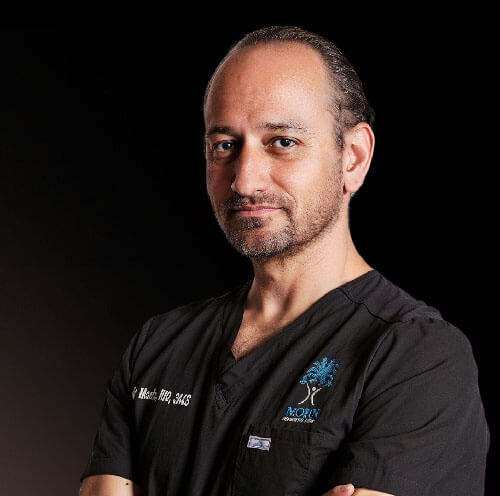Introduction:Lap-Band Surgery: Why It Works & What Are Its Shortcomings?
There is no magic wand you can wave to erase excess weight. It takes a firm commitment to healthy eating, aided by exercise that gets you moving, toned, and feeling energized.
For many individuals, however, Lap-Band Surgery can be a highly effective weight loss tool that helps you feel fuller and faster and motivates you onward toward your goal. If you've decided to consider surgery to help you lose weight, choosing a skilled surgeon and the right type of surgery is often vital to your success.
Dr. Babak is an acclaimed bariatric surgeon who has extensive skill and experience with several surgical methods that stimulate weight loss. He recommends LAP-BAND® surgery for people who are attracted to a procedure that leaves the stomach intact and are willing to be a little more patient about losing excess weight.

What is LAP-BAND?
There are three major categories of bariatric surgery:
- Restrictive surgery, limits the amount of food your stomach can hold, thus decreasing the number of calories you consume
- Malabsorptive surgery, which shortens or bypasses part of the small intestine and reduces the calories and nutrients your body absorbs
- Combination surgery, which reduces the amount of food your stomach can hold and bypasses part of the small intestine to reduce calorie and nutrient absorption
LAP-BAND is a restrictive surgery that's designed to help you consume fewer calories and lose weight by feeling fuller faster.
How does LAP-BAND work?
LAP-BAND is a laparoscopic procedure that requires just a few small incisions in your abdominal area. Specialized surgical instruments are inserted through these incisions, along with a tiny camera that Dr. Babak uses to perform the procedure.
During the surgery, Dr. Babak places a small, silicone band around the upper portion of your stomach and inflates it with saline to tighten it. This creates a small pouch at the upper stomach with a narrow channel that empties into the remainder of the stomach.
After LAP-BAND, you can expect to feel full after consuming about a cup of food. A small tube connects the band to a port that's hidden under your skin. The amount of saline in the band can be adjusted, loosened, or tightened as necessary, with a simple office visit to help improve your weight loss results.
What are the benefits of LAP-BAND?
The LAP-BAND method is less invasive than procedures that require stapling or removal of portions of your stomach. This means you can expect to heal faster and get back to normal activities sooner.
And while the goal is to keep the band in place forever, it can be surgically removed if necessary.
Because LAP-BAND does not interfere with food absorption, it reduces the risk of vitamin deficiencies after the surgery.
Side effects are otherwise rare. The most common complaint after LAP-BAND is nausea and vomiting, which is often easily addressed by adjusting the tightness of the band.
- Fewer complications: Being a simpler, reversible procedure, the lap band may have lower surgical risks than bypass or sleeve gastrectomy. Serious complications like leaks at surgery sites are less common.
- Shorter hospital stay: Patients typically go home 1-2 days after lap band surgery versus 3 or more days with bypass or sleeve procedures.
- No cutting/stapling: The band simply wraps around the stomach versus cutting out and removing parts of it. This avoids issues like digestive obstruction that can happen with staple-based procedures.
- Adjustability: The band's tightness can be tailored over time for personalized weight loss results.
- Reversibility: While all bariatric surgery can technically be reversed, lap band removal is simpler than a reversal of an anatomy-changing bypass or sleeve gastrectomy.
What are the drawbacks of LAP-BAND?
The major drawback of LAP-BAND is that it often takes many people longer to lose weight than it does with other procedures, and most can expect to lose about 40 percent of their excess weight. That compares with 60 percent or more with other methods such as gastric bypass surgery, which is both restrictive and malabsorptive.
If you're considering weight loss surgery to help you reach your goal or simply want more information about the available procedures, make an appointment at Healthy Life Bariatrics. We offer a variety of surgical and nonsurgical strategies that can help you lose weight and gain health.
Slower, Less Weight Loss
Patients typically lose around 30% of excess body weight with the lap band over 3 years. In contrast, gastric bypass typically results in 60-80% excess weight loss over the same timeframe. The most weight loss usually occurs in the first 12-18 months after surgery. Many patients are happy with a more gradual, 30% loss. However, for some, the lap band does not provide enough weight reduction to resolve obesity-related illnesses.

Requires Significant Lifestyle Change
Since the lap band promotes weight loss mainly by restricting food portions, patients must make considerable long-term changes to diet and lifestyle. Eating well-balanced, nutritious meals in proper portions is important for good health with this tool. Skipping follow-up appointments to adjust the band can also impact results. Patients must commit to regular visits with their bariatric care team.
Nausea, Vomiting, GERD Risk
Going too fast from small sips to regular meals or overeating with the band in place can trigger nausea, vomiting, heartburn, and gastroesophageal reflux disease (GERD). Eating slowly and deliberately is key. While medication can help alleviate symptoms, some patients cannot tolerate persistent nausea and gastrointestinal side effects over time, requiring band removal.
Band Slippage/Migration Risk
In some cases (5-20% incidence), the band can gradually slide down the stomach or flip upside down. This reduces its restrictive abilities, limits weight loss, and can cause problems like blockages. Additional surgery may be required to reposition or remove the band if this complication arises.
Pouch Stretching
Over long periods, the small stomach pouch above the band may stretch out from constant pressure. This allows more food intake before feeling full, limiting the device's effectiveness. Adding more saline can restrict a stretched pouch again, but removal may ultimately be required.
Esophageal Dilation
Some studies observe progressive widening or dilation of the esophagus from years of eating with band restriction. While not universally seen, this complication can lead to chronic acid reflux requiring additional surgery or band removal.
Leak/Erosion Risk
In a small percentage (around 3%) of patients, the band eventually erodes through the stomach wall. This can cause infection or abscess. Also, the port under the skin may leak due to loose tubing connections or infection. Surgical revision or lap band removal is typically required if these problems occur.
Nutritional Deficiencies
As with any bariatric surgery reducing food intake, some vitamin and mineral deficiencies may arise over time. Taking supplements can often prevent this, but regular lab testing helps monitor for conditions like anemia or osteoporosis-related to poor nutrient absorption.
Cosmetic Effects
Some patients dislike the cosmetic aspects of having a saline port directly under their skin for band adjustments. However, technological advances like port designs that sit flat against muscle or remote adjusters are helping improve discretion.
Conclusion: Lap Band Surgery Why it Works and What Are Its Shortcomings?
Considering these pros and cons, risks, and alternatives, the lap band is reasonable for certain patients. However, it may not be the optimal choice for very high BMI populations wanting to maximize weight loss from surgery. Being aware of all the facts about this tool's utility makes for informed choices about utilizing it versus other options.


